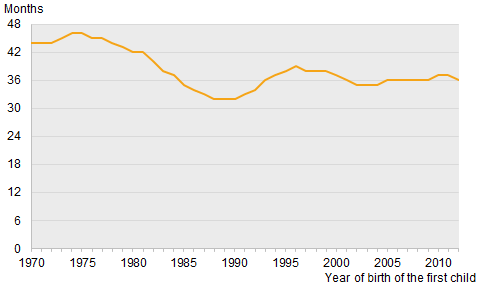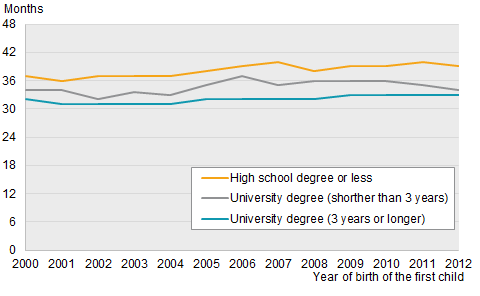Demographic analysis: Birth intervals – how long do parents wait before they have a second child?
Interval between births is shorter today than it was in the 1970s
Statistical news from Statistics Sweden 2017-11-17 9.30
The median interval between the birth of the first and second child is currently three years in Sweden, a decline compared to an interval of almost four years during the mid-1970s. The length of the interval between births differs by levels of education, age of the mother, as well as between native- and foreign-born women.
Over the last decades, men and women have had their first child at increasingly older ages in Sweden. In recent years women are on average 29 years old and men 31 years old when they have their first child. Was that postponement of childbearing accompanied by a shortening of the interval between births so that parents could accommodate having more than one child? The new report Birth intervals: How long do parents wait before they have a second child?, published today, describes changes in the duration of the interval between the first and second birth since 1970.
The study focuses on the childbearing of native-born women, although results for men and foreign-born women are also shown. The median birth interval is very similar among men and women. Foreign-born women who gave birth to their first child after migrating to Sweden are included in the study. In general, they wait longer than native-born women before having their second child. For example, the median interval between the first and second child was 48 months among women born in Europe (outside of Sweden) who had their first child in 2012. The corresponding figure among native-born women was 36 months.
Trends in birth intervals over time
Since 1970, the median interval between the first and second child was the longest among women who had their first child in 1974–75, at 46 months. The shortest interval was documented among women who had their first birth in 1988–90, circa 32 months. Parents waited longer to have a second child during the economic recession of the 1990s and the median interval between births increased during that period. Since the beginning of the 2000s the median interval between the first and the second birth has stayed around 36 months.
Median interval between the first and second child by year of birth of the first child. Women born in Sweden who had their first child between 1970 and 2012
Increasingly shorter birth intervals among older mothers
In the 1980s and 1990s, mothers who had their first child in their mid-30s waited longer than younger mothers before having a second child. However, birth intervals have since declined among women in that older age group. In recent years, women who have their first child at ages 25, 30 and 35 have their second birth within similar intervals, approximately 36 months. A shorter birth interval among older mothers means that more women are able to have a second child even if childbearing is postponed to older ages.
Those with tertiary education have shorter birth intervals
Birth intervals are shorter among women with tertiary education than among those with high school degree or less. Among women who gave birth to their first child in 2012 at ages 29-30, for instance, those with 3-year college education or more waited 33 months before giving birth to their second child. Those in the same age group in that year who had high school degree or less waited 39 months before having a second child.
Median interval between the first and second child by year of birth of the first child and educational attainment of the mother at the time of her first birth. Women born in Sweden who had their first child at ages 29–30
Definitions and explanations
The median time between the first and second child indicates how long it takes before half of all those who had their first child in given year give birth to their second child. The data includes children born in Sweden up to 2016.
Publication
Read more in the report:
Birth intervals: How long do parents wait before they have a second child?
Feel free to use the facts from this statistical news but remember to state Source: Statistics Sweden.
